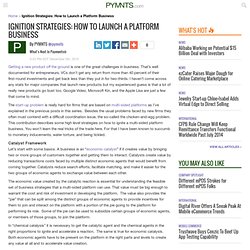

Ignition Strategies: How to Launch a Platform Business. Getting a new product off the ground is one of the great challenges in business.

That’s well documented for entrepreneurs. VCs don’t get any return from more than 40 percent of their first-round investments and get back less than they put in for two-thirds. I haven’t come across any stats for major companies that launch new products but my experienced guess is that a lot of really new products go bust too. Google Video, Microsoft Kin, and the Apple Lisa are just a few that come to mind. The start-up problem is really hard for firms that are based on multi-sided platforms as I’ve explained in the previous posts in this series. Catalyst FrameworkLet’s start with some basics.
The economic value created by the catalytic reaction is essential for understanding the feasible set of business strategies that a multi-sided platform can use. In “chemical catalysis” it is necessary to get the catalytic agent and the chemical agents in the right proportions to ignite and accelerate a reaction. Blast Off! How Two-Sided Platforms Ignited. Facebook wunderkind Mark Zuckerberg and his partners made it look easy.

The social networking platform ignited almost immediately after it was introduced at Harvard College. It didn’t take many friends seeking friends and guys seeking girls and vice versa to create enough “fissionable material” as I discussed in the last entry. Within a week, more than half of the undergrads had signed on. Facebook then repeated this over the next few years at other colleges across the country by introducing the network when this startup was sure there was critical mass at the school.
Over time these individual networks were knitted together and today, six years after its start, Facebook has more than 500 million users globally, accounts for more time than any other site including Google, and is growing quickly. Igniting a platform is hardly ever this easy, although looking backwards it may seem that way. That brings me to an important point on starting new platforms. David S. Defining "Platform" and "Platform-as-a-Service" - ReadWriteCloud. A couple of weeks ago, Alex Williams asked on the ReadWriteCloud weekly poll what people thought were the "worst terms" in cloud computing.

The results were inconclusive. Or rather, there are a number of terms we dislike. "Cloud-in-a-box," "cloudstorming," and "cloudburst" led the pack with the most votes, the latter two suggesting that we may be tiring of weather metaphors in cloud marketing. But one of the terms that has recently been on the receiving end of criticism didn't make it onto Alex's list: platform-as-a-service. Or even just "platform. " What is a Platform? Investor Brad Feld penned a rant about the term, noting that "platform" is becoming a buzzword bandied about without much concern for meaning. By extension, Gartner Research Fellow David Smith has also railed against the term platform-as-a-service, asking "Is PaaS passe yet?
" Everything's a Platform? In the case of platform, Smith writes, "Platform refers to an extensible entity, something that is built upon.